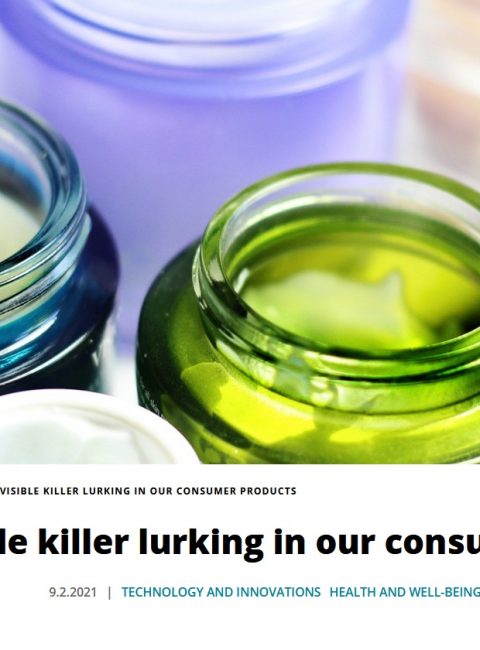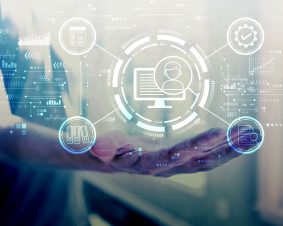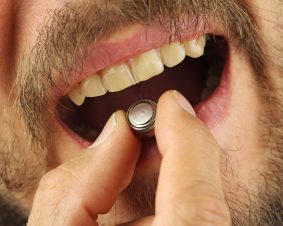 >
Spotlight April 2021: Nanomaterials and Fake News – a commentary based on an example
>
Spotlight April 2021: Nanomaterials and Fake News – a commentary based on an example
In February 2021, the article “The invisible killer lurking in our consumer products” appeared, describing nanoparticles as a greater danger than Corona [1]. “The use of nanomaterials” would be “unregulated” and “nanomaterials are so small that they cannot be determined once they are part of a product”. So what is the truth of these statements?
The article refers to a publication by Monikh et al. in which the transport of gold particles within the aquatic food chain from algae to daphnia to fish was studied [2]. To understand the uptake, accumulation and distribution of nanogold particles, both the number of particles and the mass were determined. The authors were able to show that only a small proportion of the gold particles ingested by algae were detectable in the fish (0.03%- 0.48%) and that a large proportion of the gold was excreted (49-58%).
The scientific achievement of this study lies in the development of a reliable method to determine the transfer of nanomaterials in a food chain. The transformation of the particles during their transfer through different organisms is taken into account (size, solubility). It is also possible to determine exactly in which parts of an organism particles are found and whether there is an accumulation via the food chain (which is not the case). The gold nanoparticles which were used should be considered as model particles, which were selected because of their good detectability. A general statement regarding the transfer of other nanomaterials through food chains cannot be derived from this.
In the publication by Monikh et al. no comparison was made with Corona and the allegedly non-existent regulation of nanomaterials is also not mentioned. Why then is it mentioned in the article on chemeurope.com?
One possible explanation could be that lurid and emotionally written texts reach a larger number of readers and are shared more often. Texts that play with human fear and generate the signal “danger” in the readers mind, spread faster. In the case of the example text, it is already clear from the headline that the word “killer” creates fear and that “our consumer products” are intended to address a broad target audience. Fake news is characterised by making claims that are not proven (no source is cited) or that statements are greatly reduced and thus a false picture is reproduced. Therefore, it is worthwhile to look at the original sources (if available).
In the case of the article, parts have been corrected (namely the sentences mentioned above), but the original article as well as the German translation is still available on chemeurope.com and the reference to the cited scientific study remains unclear [3,4].
Original publications:
[2] Abdolahpur Monikh, F., Chupani, L., Arenas-Lago, D. et al. Particle number-based trophic transfer of gold nanomaterials in an aquatic food chain. Nat Commun 12, 899 (2021).
[3] https://www.uef.fi/en/article/the-invisible-killer-lurking-in-our-consumer-products

Weitere Spotlights
Spotlight September: A methodology for the automatic evaluation of data quality and completeness of nanomaterials for risk assessment purposes
This paper describes a method for automatically assessing the quality and completeness of nanosafety data for the purpose of risk assessment. Steps to develop the methodology for assessing data completeness and the methodology for assessing quality are presented. The methodology is tailored to physicochemical and hazard (meta) data, but can also be configured with appropriate […]
Read moreSpotlight May 2023: Dual energy – edible batteries
An Italian research group reports on edible batteries that supply electric current and can be digested as food, thus providing energy a second time. What sounds funny at first has a serious background, because in medicine, power sources are needed that could be transported through the digestive tract and possibly remain in the body unintentionally, […]
Read moreSpotlight June 2021: Endotoxin – the reason for false-positive toxicity testing for advanced materials?
Advanced materials, but also nanomaterials are closely examined to determine whether they trigger biological effects that could be harmful to humans and the environment before they are used in products. This also includes such materials as titanium dioxide, which has been used in a wide variety of products for more than 50 years. A particularly […]
Read moreSpotlight November 2021: Safe Materials from Scratch – Safe-by-Design in Materials Research
Advances in the field of materials science continue to amaze us with nanoscale materials with extraordinary chemical, electrical, optical, and numerous other properties. However, some nanoscale materials have different toxicological profiles compared to the same bulk material. Since safety issues are usually addressed just before launching a product into the market, safety issues may be […]
Read more

